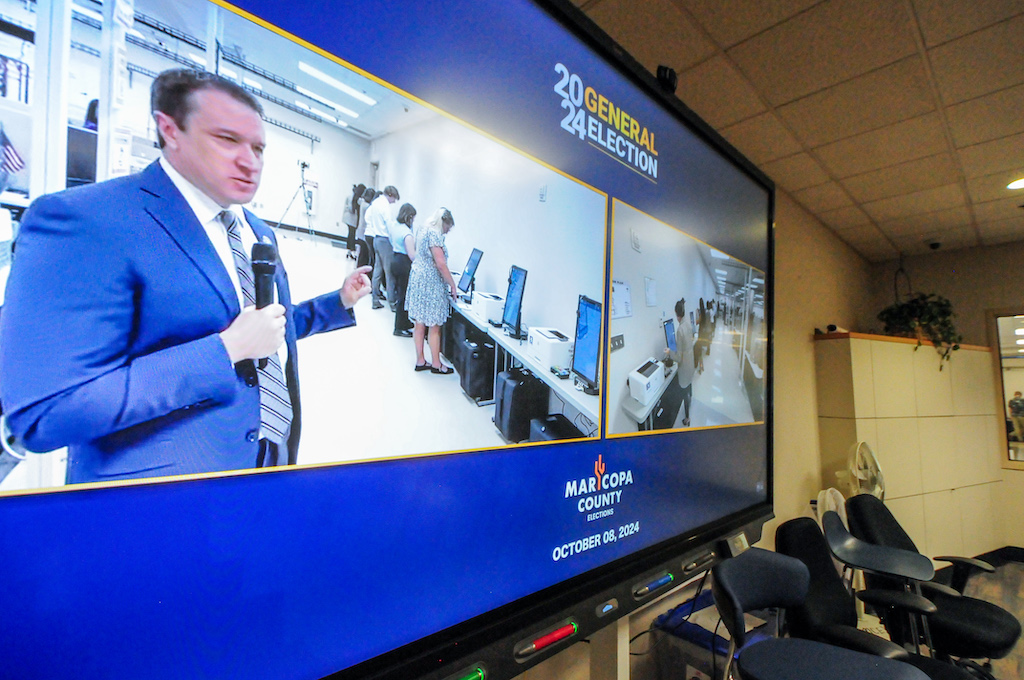(Phoenix, Arizona) — A large, paneled wall with four wide windows separated two groups at the Maricopa County Tabulation and Election Center (MCTEC) in Phoenix, Arizona. Behind the glass, election workers conducted a thorough ballot tabulator test, the machines responsible for tallying voter ballots on Election Day. With the November 5 general election nearing, this public test, streamed live, aimed to reinforce trust in Maricopa County’s election system.
In the observation area, credentialed journalists recorded the day’s events, capturing the test’s progress through the windows. With limited access to the room itself, media crews found the best angles they could, focusing on election workers and two bipartisan observers, one Democrat and one Republican. These participants simulated Election Day by feeding sample ballots into the tabulators, echoing the real process that will soon be used to process nearly two million votes.
Related → From ballots to results: a journey through Maricopa County Tabulation and Election Center

Why tests like this matter
The electoral process in the United States is multi-layered and complex, with numerous safeguards to maintain integrity. Tests like the one at MCTEC play a critical role in this system, providing transparency to counter misinformation and assuring voters of the accuracy of election equipment.
Ballot tabulators are essential to the counting process, converting marked ballots into numerical data that represents voter preferences. Ensuring their accuracy is especially important in a climate of heightened scrutiny following the 2020 election, when public confidence in voting machinery became a focal point.

Inside the role of ballot tabulators
At MCTEC, workers simulated real election conditions, running a “logic and accuracy” test designed to ensure equipment is properly calibrated. Maricopa County officials noted that these tests are conducted both before and after each election cycle, an additional layer of verification to confirm tabulators’ programming and functionality.
These machines provide essential benefits: they accelerate the counting process, reduce human error, and help release accurate results in a timely manner. This efficiency is crucial in an era where swift and accurate results help build public trust in the electoral system.
Democracy in action: preparing for election day
Maricopa County’s recent tests reflect the many measures election workers undertake to uphold democratic principles. This public demonstration not only verified technical readiness but also underscored a commitment to transparency and voter trust.
With Election Day just around the corner, this “democracy test” highlights the processes in place to ensure a fair and accurate vote count. By educating the public on tabulator functions and the measures protecting voter rights, officials hope to foster an informed electorate ready to participate.
As the final weeks wind down, every effort counts to guarantee that democracy is not just a test but a well-executed reality on Election Day. These rigorous standards for transparency and accuracy form a solid foundation for a democratic process that respects and reflects the will of the people.
Quick Facts
• Election Day: November 5
• Voter Count: Approximately 2.1 million Maricopa County voters are expected
• Two-Page Ballots: For the first time since 2006, Maricopa voters will use a two-page ballot.
Post-Test Update: Following the ballot tabulator test, officials reported that over 2,500 sample ballots were counted with bipartisan observers confirming an exact match in results.
© 2024, Eduardo Barraza. All rights reserved.




